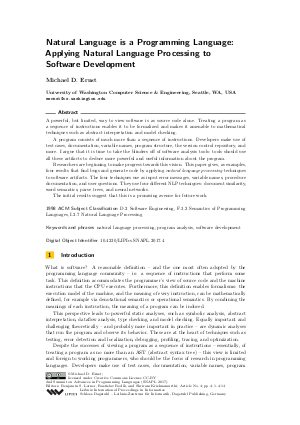Natural Language is a Programming Language: Applying Natural Language Processing to Software Development
Author Michael D. Ernst
-
Part of:
Volume:
2nd Summit on Advances in Programming Languages (SNAPL 2017)
Part of: Series: Leibniz International Proceedings in Informatics (LIPIcs)
Part of: Conference: Summit on Advances in Programming Languages (SNAPL) - License:
 Creative Commons Attribution 3.0 Unported license
Creative Commons Attribution 3.0 Unported license
- Publication Date: 2017-05-05
File

PDF
LIPIcs.SNAPL.2017.4.pdf
- Filesize: 0.5 MB
- 14 pages
Document Identifiers
Subject Classification
Keywords
- natural language processing
- program analysis
- software development
Metrics
- Access Statistics
-
Total Accesses (updated on a weekly basis)
0Document
0Metadata
Abstract
A powerful, but limited, way to view software is as source code alone. Treating a program as a sequence of instructions enables it to be formalized and makes it amenable to mathematical techniques such as abstract interpretation and model checking. A program consists of much more than a sequence of instructions. Developers make use of test cases, documentation, variable names, program structure, the version control repository, and more. I argue that it is time to take the blinders off of software analysis tools: tools should use all these artifacts to deduce more powerful and useful information about the program. Researchers are beginning to make progress towards this vision. This paper gives, as examples, four results that find bugs and generate code by applying natural language processing techniques to software artifacts. The four techniques use as input error messages, variable names, procedure documentation, and user questions. They use four different NLP techniques: document similarity, word semantics, parse trees, and neural networks. The initial results suggest that this is a promising avenue for future work.
Cite As Get BibTex
Michael D. Ernst. Natural Language is a Programming Language: Applying Natural Language Processing to Software Development. In 2nd Summit on Advances in Programming Languages (SNAPL 2017). Leibniz International Proceedings in Informatics (LIPIcs), Volume 71, pp. 4:1-4:14, Schloss Dagstuhl – Leibniz-Zentrum für Informatik (2017)
https://doi.org/10.4230/LIPIcs.SNAPL.2017.4
BibTex
@InProceedings{ernst:LIPIcs.SNAPL.2017.4,
author = {Ernst, Michael D.},
title = {{Natural Language is a Programming Language: Applying Natural Language Processing to Software Development}},
booktitle = {2nd Summit on Advances in Programming Languages (SNAPL 2017)},
pages = {4:1--4:14},
series = {Leibniz International Proceedings in Informatics (LIPIcs)},
ISBN = {978-3-95977-032-3},
ISSN = {1868-8969},
year = {2017},
volume = {71},
editor = {Lerner, Benjamin S. and Bod{\'\i}k, Rastislav and Krishnamurthi, Shriram},
publisher = {Schloss Dagstuhl -- Leibniz-Zentrum f{\"u}r Informatik},
address = {Dagstuhl, Germany},
URL = {https://drops.dagstuhl.de/entities/document/10.4230/LIPIcs.SNAPL.2017.4},
URN = {urn:nbn:de:0030-drops-71357},
doi = {10.4230/LIPIcs.SNAPL.2017.4},
annote = {Keywords: natural language processing, program analysis, software development}
}
